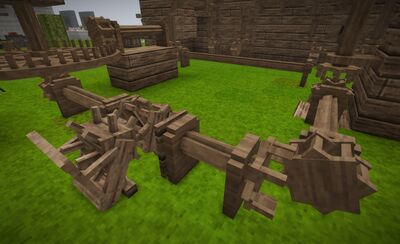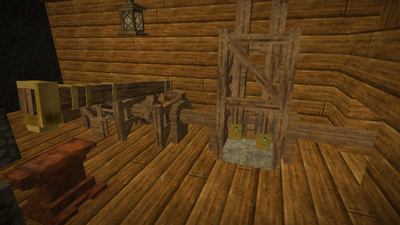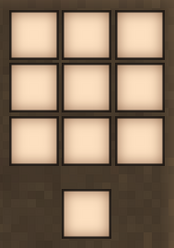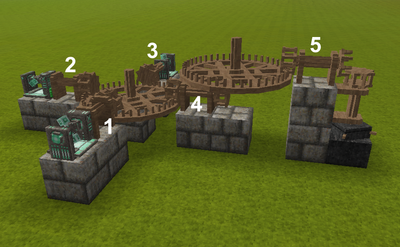Energía mecánica
La mecanización es el camino hacia la prosperidad.
La energía mecánica es una mecánica que permite alimentar distintas máquinas mediante el aprovechamiento de energías renovables (como el viento) a través de estructuras como el molino de viento. En la actualidad, se puede utilizar para automatizar molinos para moler, martinetes para trabajar escorias de hierro o forjar placas de metal, y pulverizadores para triturar materiales en su forma en polvo. Aunque se puede utilizar para accionar una sola máquina, con una serie de conexiones de ejes y engranajes se puede hacer lo que se llama un tren de potencia. Esto permite conectar varias máquinas a la vez, trabajando en tándem.
Fuentes de energía mecánicas
El molino de viento
Un molino de viento es una estructura de varios bloques utilizada para aprovechar la energía eólica y transformarla en energía mecánica. Hay muchos diseños posibles para un molino de viento, pero los factores a tener en cuenta incluyen:
- Ubicación velocidad del viento
- Altura - para el viento y espacio libre para las velas
- Acomodación de diversos diseños y equipos de grupos motopropulsores
- Cantidad de energía necesaria para accionar los equipos conectados
Encontrará información detallada sobre el molino de viento en la página el molino de viento.
Otros
Otras fuentes son el Rotor automático (sólo creativo).
Tren de energía
Una serie de ejes, engranajes, frenos y otros mecanismos interconectados que permiten un flujo ininterrumpido de energía mecánica a través de varias máquinas al mismo tiempo.
Materiales necesarios para un tren de energía
Ejes de madera
Se utilizan para transmitir la energía eólica en línea recta. Pueden colocarse vertical u horizontalmente en cualquiera de los puntos cardinales.
| Ingredients | Crafting Recipe |
|---|---|
| 1x Martillo 1x Cincel 1x Tronco 1x Grasa |
Engranajes de madera
Permiten que la energía mecánica realice un giro en ángulo recto conectando un eje horizontal a uno vertical. A menudo necesario en función del diseño del tren de potencia.
| Ingredients | Crafting Recipe |
|---|---|
| 1x Martillo 1x Sierra 2x Palo 1x Cincel 1x Resina 1x Tronco 1x Grasa |
Freno
Puede utilizarse para aplicar mucha resistencia al mecanismo con el fin de detener todo el tren.
| Ingredients | Crafting Recipe |
|---|---|
| 1x Martillo 1x Cincel 1x Tronco 1x Wooden axle 2x Resina |
Clutch and transmission
When placed together can be used to interrupt flow of energy to a specific branch of the power train.
Large wooden gear
Allows to combine power from multiple sources, or distribute power from single source to multiple consumers. Can also be used to increase rotational speed at the cost of decreasing the torque, and vice-versa.
| Ingredients | Crafting Recipe |
|---|---|
| 4x Large gear section 24x Board 1x Wooden axle |
Input and output
Input and output is handled using chutes, hoppers and optionally chests. Hoppers accept multiple stacks of input items, which are then transported via chutes towards the input slot of an eligible block. Chutes can also grab items directly from chests. A special type of chute, the Archimedes screw, can transport items upward provided it is powered.
Hopper (optional)
Used for material input/output. Crafted directly from copper plates.
| Ingredients | Crafting Recipe |
|---|---|
| 3x Plancha de Metal |
Chute (optional)
Used to transfer materials between hoppers, chests, other containers and various machinery. These blocks can be placed directionally, with the output facing away from the player. Chutes are crafted from chute sections, which need to be crafted on an anvil with copper ingots, by hand or with the help of a helve hammer. As even the straight chute needs at least two sections, a minimum of two copper ingots is necessary for one chute.
Note: Chutes can be rotated using a wrench.
| Ingredients | Crafting Recipe |
|---|---|
| 2x Chute section |
| Ingredients | Crafting Recipe |
|---|---|
| 2x Chute section |
Advanced power trains
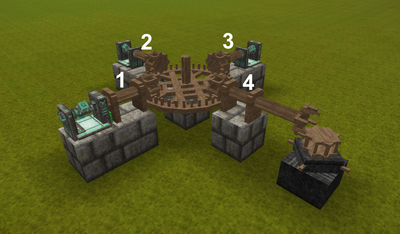
To build complex and efficient power trains it's important to understand relation between speed and torque, and how they are affected by resistance of a given mechanical system.
- Resistance defines how much rotational energy the system needs in order to continuously operate. If there is not enough torque to counteract resistance, entire power train will lose speed or even come to a complete halt. Each element of the system, such as axles, gears and transmissions, has some resistance. However, machinery doing useful work tends to contribute the most.
- Torque is a measure of rotational force and directly counteracts resistance. Adding more torque to the system can help it overcome the resistance of connected machinery, allowing faster operation. However, as soon as resistance is completely overcome - there is no point in further increasing the torque.
- Speed defines the rate at which machines in the system perform their job. Increasing the speed allows for faster operation, but only if there is enough torque to sustain it; otherwise most of the speed will be lost to resistance.
Large wooden gear
Conversion of torque to speed and vice-versa can be achieved with the help of large wooden gear. Central shaft and rim of the gear can both be used for input or output. Direction of the power flow defines the conversion.
- Using shaft as input and rim as the output allows to increase the speed by a factor of 5, at the cost of reducing the torque by the same factor;
- Using rim as input and shaft as the output allows to achieve the opposite effect, increasing the torque by a factor of 5 and decreasing speed by the same factor;
- Using rim as input for multiple power sources allows to combine the torque from those sources, while resulting speed will be defined by the fastest input;
- Using rim as input for single power source allows to distribute that energy to multiple outputs, conserving speed and torque.
As evident from example of complex gear setup on this page, multiple gears can be used together to achieve desired conversion and distribution of energy.
Maquinaria automatizada
Molienda
Mecanizados o no, los molinos permiten al jugador moler grano, así como algunos minerales y piedras en sus formas procesadas. Para la molienda mecanizada, el molino debe estar conectado a un tren de energía que funcione..
Los Molinos pueden automatizarse aún más con el uso de tolvas, toboganes y cofres. Para ver la guía completa de automatización, consulta la página molino.
- See also Quern.
Mechanized or not, querns enable the player to grind grain, as well as some minerals and stones into their processed forms. For mechanized milling, the quern must be attached to a functioning power train.
Querns can be automated further with the use of hoppers, chutes and chests.
Herrería
Un martinete puede ayudar al jugador a procesar lingotes de hierro y acero cementado, así como a fabricar planchas de cualquier tipo de metal. Requiere energía mecánica para funcionar y no hay forma práctica de automatizar la entrada y salida de materiales, ya que se adhiere a los mismos principios que la herrería manual. Para obtener la guía de configuración completa, consulta la página martinete.
- See also Helve hammer.
A helve hammer can help the player in processing iron blooms and blister steel, as well as making plates of any metal type. It requires mechanical power to operate and there is no practical way to automate the in- and output of materials, since it adheres to the same principles as manual smithing.
Trituración
Véase también Pulverizador.
El pulverizador permite a los jugadores triturar ciertas piedras y minerales hasta convertirlos en polvo fino que se puede utilizar para fabricación de acero o tinturas. No hay otra forma de obtener estos materiales. Una configuración completa del pulverizador requiere una inversión significativa de tablas y metal para el armazón, la palanca, los machacadores y las tapas.
Videos tutoriales
| Explanation of large gear usage | General guide on mechanical power | How to build a windmill and helve hammer in 1.13 |
|---|---|---|
| Wiki Navigation | |
|---|---|
| Vintage Story | Guías • Preguntas más frecuentes (FAQ) • Vintage Story Original Soundtrack • Versiones • Controles |
| Mecánicas de juego | Fabricación • Talla Lítica • Alfarería • Herrería • Cocina • Temperatura • Hambre • Minería • Estabilidad temporal • Energía mecánica • Comercio • Agricultura • Ganadería |
| Mundo | Generación del Mundo • Biomas • Clima • Tormentas temporales |
| Objetos | Herramientas • Armas • Armadura • Ropa • Mochilas • Materiales • Comida |
| Bloques | Terreno • Plantas • Decorativo • Iluminación • Functional • Minerales |
| Entidades | Entidades hostiles • Animales • NPCs • Jugadores |
| Miscellaneous | List of client commands • Lista de comandos del servidor • Creative Starter Guide • Bot System • Cómo utilizar Worldedit • Cinematic Camera • Adjustable FPS Video Recording • ServerBlockTicking |
